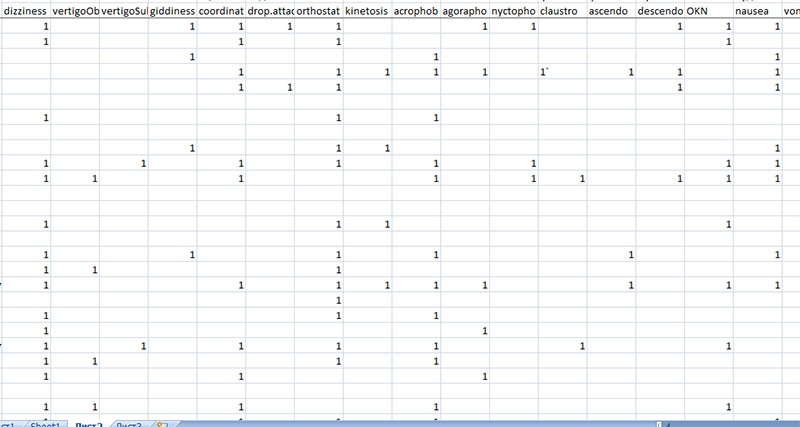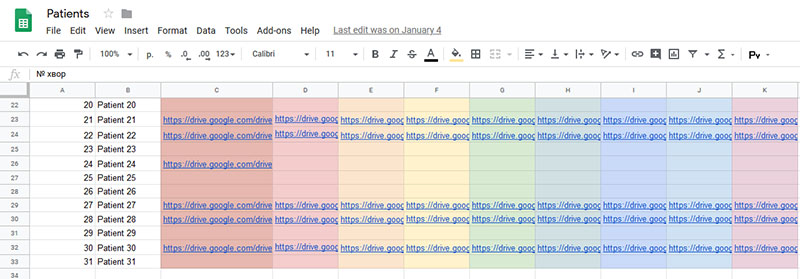Questionnaire is organic part of the International Clinical Protocol on Vestibular Disorders (Dizziness).
Questionnaire is present at table form. The most beneficial feature of the Google Table opposite to Excel is possibility to put picture, video or link into the table sell. Cloud is very easy!
Questionnaire
Date of investigation
Patient name
Age
Today residence
Accidents (Chornobyl, Three-Mile-Island, Spitak, Chechnia)
- Gender
- Height
- Weight
- Weight changes
Profession
Professional hazards
General duration of disease
Allergy
Head trauma
Reason of disease
Intoxications
Main diagnosis
Patient evaluation of dizziness intensity:
- 0 Dizzy spells are absent,
- 1 Low intensity – everyday activities are easy going both professional and home,
- 2 Half low – everyday activities are slightly disturbed,
- 3 Middle – everyday activities are disturbed,
- 4 Intensive – it is difficult to perform everyday activities,
- 5 Very intensive – everyday activities are impossible to be done.
Dizziness – distortion of perception of space, movement and time
Objective vertigo – sensation the subjects moving around the patient
Subjective vertigo – illusion of nonexistent movement, patient fill him moving
Imbalance (movement coordination disturbance) – sometimes is met alone. Patients are complaining of swaying, staggering, momentary push…
Orthostatics – discomfort sensations which appear after sudden standing up.
Kinetosis – a disorder caused by repetitive angular and linear acceleration and deceleration and characterized primarily by nausea and vomiting.
Acrophobia (height vertigo, height dizziness) – discomfort which appears at height.
Agoraphobia (supermarket syndrome) – (αγωρα – Grecian, market) discomfort in open, public places or crowds.
Nyctophobia – discomfort, insureness in darkness and twilight.
Claustrophobia – discomfort appearing in small, closed spaces
Ascendophobia – discomfort while moving upstairs, patients note the necessity for visual control.
Descendophobia – discomfort during walking down the hill or descending the staircase, patients note the necessity of visual control.
Optokinesis – discomfort evoked by optokinetic stimuli, train or cars movement, sunrays blinking through the row of trees etc.
Nausea is identified as urge to vomit.
Vomiting – is forceful expulsion of gastric contents.
Headache as a substitute of dizziness
Black-out might appear during sudden movements of head, physical loadings or per se
Tinnitus as dizziness substitute
Numbness is unpleasant sensation of temporary loss of volunteer control of the parts of the body.
Headache regular – more often then once per month.
Patient evaluation of headache spell intensity:
- 0 Headache spells are absent,
- 1 Low intensity – everyday activities are easy going both professional and home,
- 2 Half low – everyday activities are slightly disturbed,
- 3 Middle – everyday activities are disturbed,
- 4 Intensive – it is difficult to perform everyday activities,
- 5 Very intensive – everyday activities are impossible to be done.
Headache unilateral.
Headache flickering.
Aura (headache precursor) visual
Scotoma – black spots
Photopsia – white spots
Teichopsia – white lines
Flickering
Aura acoustic – hearing phenomena as headache precursors
Aura somatosensory – numbness as headache precursor
Aura vestibular – giddiness or vertigo as headache precursor
Headache accompanied with nausea
Headache accompanied with vomiting episode, usually with some relief.
Phonophobia – sounds become unpleasant during headache spell
Photophobia – light become unpleasant during headache spell.
Osmophobia – fragrances become unpleasant during headache spell.
Vertigo – intensive vertigo during headache spell not resembling other types of vertigo, it is more close to giddiness or pseudovertigo.
Duration of headache spell
Meteosensitivity – weather changes provoke headache attack or dizziness
Lunatism – moon cycles provoke headache attack or dizziness.
Magnetosensitivity – magnetic storms, handy etc provoke headache attack or dizziness.
Pain in the heart area
Dispnoe attacks
Palpitations
Extrasystole, rhythm disturbances
ECG intervals:
- P
- PQ
- QRS
- ST
Blood pressure:
- Systolic
- Diastolic
Pulse rate
Cholesterol
High density lipoproteins
Low density lipoproteins
Aterogenity index
Blood glucose
20-score battery for coordination evaluation: complaints
- Test of Uemura
- Test of Fukuda stepping
- Test of Fukuda writing
- Test of indication
- Test of tracking
Total:
- IgG HSV 1 immunoglobulin G to type 1 herpes
- IgG HSV 2 immunoglobulin G to type 2 herpes
- IgG HSV immunoglobulin G to type rozeola herpes
- IgG CMV immunoglobulin G to cytomegalovirus
- Heterofilic antibodies (IgG EBV)
Medication used
Below you can see examples excel and google tables we used


The original Google table is here
You can also get free course “Cloud technologies in medicine”
Copyright LITA Corp.

